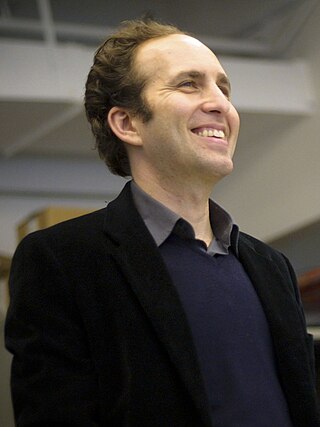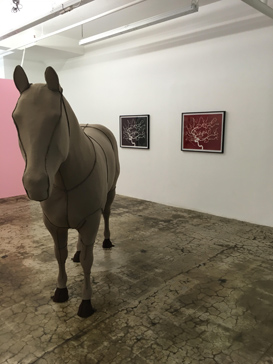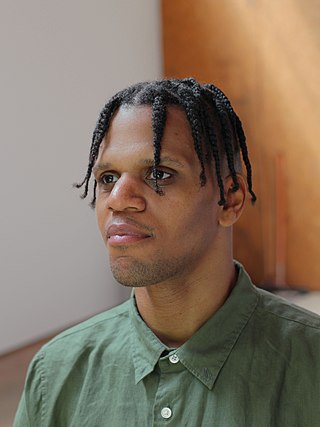Related Research Articles

Hito Steyerl is a German filmmaker, moving image artist, writer, and innovator of the essay documentary. Her principal topics of interest are media, technology, and the global circulation of images. Steyerl holds a PhD in philosophy from the Academy of Fine Arts Vienna. She has been a professor of Current Digital Media at the Academy of Fine Arts in Munich since 2024. Until 2024, she was a professor of New Media Art at the Berlin University of the Arts, where she co-founded the Research Center for Proxy Politics, together with Vera Tollmann and Boaz Levin.
InterAccess is a Canadian artist-run centre and electronic media production facility in Toronto. The Centre for Contemporary Canadian Art places the founding of InterAccess as a key moment in both the history of Canadian electronic art but also within a timeline of developments in international art, science, technology and culture.

Flaming Lotus Girls is a volunteer-based group of artists who make large-scale kinetic fire art. FLG has been described as a "women-focused anarchist art collective." The group began in 2000, in San Francisco, California, as a group of six women and two men who wanted to gain the fabrication skills and design experience needed to create large sculptural installations. The group includes over a hundred members of all genders, and a majority of the members are women. Many of the sculptures have interactive elements, allowing the audience to control the lighting, flames, sound, or other effects. The collective's work has appeared throughout the United States, as well as in Canada, Australia, and the Netherlands.

Peter Halley is an American artist and a central figure in the Neo-Conceptualist movement of the 1980s. Known for his Day-Glo geometric paintings, Halley is also a writer, the former publisher of index Magazine, and a teacher; he served as director of graduate studies in painting and printmaking at the Yale University School of Art from 2002 to 2011. Halley lives and works in New York City.
Camille Utterback is an interactive installation artist. Initially trained as a painter, her work is at the intersection of painting and interactive art. One of her most well-known installations is the work Text Rain (1999).

Scott Snibbe is an interactive media artist, author, entrepreneur, and meditation instructor who hosts the Skeptic's Path to Enlightenment meditation podcast. His first book, How to Train a Happy Mind, was released in 2024. Snibbe has collaborated with other artists and musicians, including Björk on her interactive “app album” Björk: Biophilia that was acquired by New York's MoMA as the first downloadable app in the museum's collection. Between 2000 and 2013 he founded several companies, including Eyegroove, which was acquired by Facebook in 2016. Early in his career, Snibbe was one of the developers of After Effects.
Liz Phillips is an American artist specializing in sound art and interactive art. A pioneer in the development of interactive sound sculpture, Phillips' installations explore the possibilities of electronic sound in relation to living forms. Her work has been exhibited at a wide range of major museums, alternative spaces, festivals, and other venues, including the Whitney Museum of American Art, the San Francisco Museum of Modern Art, the Spoleto Festival USA, the Walker Art Center, Ars Electronica, Jacob's Pillow, The Kitchen, and Creative Time. Phillips' collaborations include pieces with Nam June Paik and the Merce Cunningham Dance Company, and her work has been presented by the Cleveland Orchestra, IBM, and the World Financial Center. She is often associated with, and exhibited alongside other early American sound artists Pauline Oliveros, John Cage and Max Neuhaus.

Shu Lea Cheang is a Taiwanese-American artist and filmmaker who lived and worked in New York City in the 1980s and 1990s, until relocating to Europe in 2000. Cheang received a BA in history from the National Taiwan University in 1976 and an MA in Cinema Studies from New York University in 1979. Since the 1980s, as a multimedia and new-media artist, she has navigated topics of ethnic stereotyping, sexual politics, and institutional oppression with her radical experimentations in digital realms. She drafts sci-fi narratives in her film scenario and artwork imagination, crafting her own “science” fiction genre of new queer cinema. From homesteading cyberspace in the 1990s to her current retreat to post net-crash BioNet zone, Cheang takes on viral love, bio hack in her current cycle of works.
Surveillance art is the use of technology intended to record human behavior in a way that offers commentary on the process of surveillance or the technology used to surveil. Surveillance art manifests itself in many different forms, from short films to architecture, but all have been shown to provide some type of critical response to the rise of surveillance by various authorities and the technology used to achieve it, especially when dealing with issues of security and enforcing laws.
Nina Sobell is a contemporary sculptor, videographer, and performance artist. She began creating web-based artworks in the early 1990s.
Liz Deschenes is an American contemporary artist and educator. Her work is situated between sculpture and image and engages with post-conceptual photography and Minimalism. Her work examines the fluidity of the medium of photography and expands on what constitutes the viewing of a photograph. Deschenes has stated that she seeks to "enable the viewer to see the inconstancy of the conditions of display, which are always at play but sometimes hard to see." Her practice is not bound to a single technology, method, process, or subject, but to the fundamental elements of photography, such as light, paper, chemistry, and time.

UNIT9 is a multidisciplinary production company working in different interactive areas: films, games, virtual reality and digital technology. Founded in 1997, UNIT9 operates globally with offices in London, Los Angeles, New York, Florence, Berlin and Poland. Directors, writers and technologists work collaboratively to create content, advertising, utility and gaming. Ad Age Production Company A-List, UNIT9 partners with advertising agencies worldwide on the digital components of campaigns.

Lindsay Howard is an American curator, writer, and new media scholar based in New York City whose work explores how the internet is shaping art and culture.

Athens Digital Arts Festival (ADAF) is an international festival that takes place every May in Athens, Greece.

Addie Wagenknecht is an American artist and researcher living in New York City and Liechtenstein. Her work deals primarily with pop culture, feminist theory, new media and open source software and hardware. She frequently works in collectives, which have included Nortd Labs, F.A.T. lab, and Deep Lab. She has received fellowships and residencies from Eyebeam, Mozilla, The Studio for Creative Inquiry at Carnegie Mellon University and CERN.
Sondra Perry is an interdisciplinary artist who works with video, computer-based media, installation, and performance. Perry's work investigates "blackness, black femininity, African American heritage" and the portrayal or representation of black people throughout history, focusing on how blackness influences technology and image making. Perry explores the duality of intelligence and seductiveness in the contexts of black family heritage, black history, and black femininity. "Perry is committed to net neutrality and ideas of collective production and action, using open source software to edit her work and leasing it digitally for use in galleries and classrooms, while also making all her videos available for free online. This principle of open access in Perry's practice aims to privilege black life, to democratize access to art and culture, and to offer a critical platform that differentiates itself from the portrayal of blackness in the media". For Perry, blackness is a technology which creates fissures in systems of surveillance and control and thus creates inefficiency as an opportunity for resistance.

Liz Young was a Los Angeles-based artist known for diverse work investigating body- and nature-focused themes, such as loss, beauty, the inevitability of decay, and the fragility of life. She produced sculpture, installation, performance, painting, drawing and video incorporating fabricated and recontextualized found objects, organic materials, and processes from industrial metalworking to handicrafts, taxidermy and traditional art practices. Young exhibited throughout the United States and Europe, including solo shows at the Los Angeles County Museum of Art (LACMA) and Los Angeles Contemporary Exhibitions (LACE), and alternative spaces such as Hallwalls, Randolph Street Gallery (Chicago) and New Langton Arts ; she participated in group shows at Exit Art, Art in the Anchorage, and Armory Center for the Arts, among others. Her art was discussed in ARTnews, Artforum, Frieze, Los Angeles Times, The New York Times, and The Village Voice, and is included in the LACMA permanent collection. Critic Peter Frank wrote that her work "reflects both on life's relentless erosion of body and spirit, and on our indomitable struggle against these nagging cruelties." Artillery Magazine critic Ezrha Jean Black called her 2017 installation a "mordant yet elegiac show" in which "craft bears out the work’s consciousness." In 2016, Young received a Guggenheim Foundation Fellowship; she was recognized with awards from the Getty Trust and Andy Warhol Foundation, among others. Young lived and worked in Los Angeles from 1981.
RaFia Santana is a non-binary American artist, musician, and performer based in Brooklyn, NY. Her work ranges from animated gifs to self-portraiture, videos, and performance to editioned clothing and electronic music exploring gentrification, the millennial mindset, mental health, and the lived black experience. They use the internet as a medium to share their artwork, empower black and brown communities, and challenge ideas of solidarity and alliance. She had exhibitions and/or performances at the Eyebeam, AdVerse Fest, SleepCenter, Times Square Arts, International Center of Photography, Schomburg Center for Research in Black Culture, Babycastles, Museum of the Moving Image and Museum of Contemporary African Disaporan Arts, Roots & Culture amongst many notable venues. Her work has been featured in publications such as Huffington Post, HyperAllergic, Rhizome, ArtFCity, Vogue, Teen Vogue and Salon. They have participated in panels, performances and discussions such as Cultured Magazine, "Late at Tate Britain", Creative Tech Week NYC, Afrotectopia at Google NYC, NYU, "Black Portraitures IV: The Color of Silence" at Harvard University and International Center for Photography. Their music is released through Never Normal Records.
Steve Parker is an artist and musician in Austin, Texas. He is the winner of the Rome Prize, the Tito's Prize, a Fulbright Fellowship, and grants from the National Endowment for the Arts.

American Artist is a contemporary artist working in new media, video, installation and writing. They legally changed their name to American Artist in 2013, in order to re-contextualize the definition of the term "American artist"—at once taking on the name of an anonymous term while becoming the embodiment of its meaning. Their work, in Artist's words, focuses on themes surrounding "blackness, being, and resistance in the context of networked virtual life."
References
- 1 2 3 4 5 6 7 8 "Artist Profile: Elizabeth Mputu". Rhizome. Retrieved 2019-06-05.
- 1 2 3 "Elizabeth Mputu - UW Artist Talk / Disjecta Performance". Mad Mimi. Retrieved 2019-06-05.
- 1 2 3 4 5 "Artist Liz Mputu Talks Surveillance Culture, Mysticism and "Broken Windows"". PAPER. 2016-09-23. Retrieved 2019-06-05.
- 1 2 3 4 Pm, Leah St Lawrence (23 October 2017). "And When I Get That Feeling I Want Virtual Healing: Elizabeth Mputu Installation at Interstitial". The Stranger. Retrieved 2019-06-05.
- ↑ Nguyen, Minh (2017-09-13). "Liz Mputu Creates a Physical Testing Zone for Digital Spirituality". Seattle Weekly. Retrieved 2019-06-05.
- ↑ "interstitial". www.interstitialtheatre.com. Retrieved 2019-06-05.
- 1 2 3 "CYBER SERENITY BY 100%LIZ". Storenvy. Retrieved 2019-06-05.
- ↑ "Alembic I: Mystic Body". Res. 2018-01-08. Retrieved 2019-06-05.
- ↑ Shell, Blake. "A Situation of Meat". disjecta. Retrieved 2019-06-05.